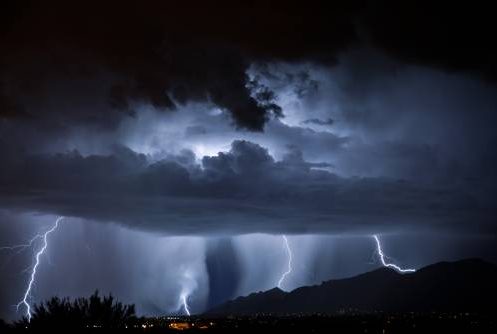When an electrical storm causes lightning to strike your home, the surge of power can damage your home’s electrical system and all the things connected to it. Even if you have surge protectors plugged into individual outlets, these appliances simply can’t handle high-power surges caused by lightning. The only way to protect your electrical system, appliances and electronics from lightning is whole-home surge protection.
How Many Volts Does Lightning Deliver?
According to the National Weather Service, the average lightning strike carries about 300 million volts of electricity. Moreover, major lightning strikes can carry up to one billion volts. To put this in perspective, the current that travels through the wiring in your home is just 120 volts. While the typical lightning flash has approximately 30,000 amps, most homes are wired with a combination of 15-amp receptacles and 20-amp circuits.
How Much Damage Can a Direct Lightning Strike Cause?
The sheer power of a lightning strike means that even a single hit can spell devastation for residential properties. Depending upon where lightning strikes and the level of surge protection in place, these events can damage several components of your home’s electrical system including:
- Sockets
- Switches
- Fixtures
- Appliances
- Electronics
How Surge Protection Could Help
Unfortunately, there isn’t a way to fully protect your home from the damage caused by lightning. However, it is possible to reliably mitigate these events and minimize the destruction and loss that they cause. Unlike single-outlet surge protection, whole-home surge protectors account for these events. Also known as whole-house surge arresters, they’re designed to handle the far greater amperage and voltage of lightning strikes.
What to Know About Whole-Home Surge Protection
Surprisingly, lightning doesn’t have to actually strike your home or even the land around it to cause major damage. It can simply strike a power line leading to your home and send a sudden surge current through your electrical system.
Whole-home surge protectors are installed directly at the main electrical panel. When excess power travels into your home, these devices direct it away from the building and into the ground. Lightning arresters are typically installed at outside generators or other entry points. They also divert excess energy from lightning strikes into the ground, but they’re installed in areas where direct lightning hits are most likely to occur.
Is It Time to Implement or Upgrade Your Home’s Surge Protection Plan?
Taking a do-it-yourself approach to surge protection might seem easy enough, but it could leave you with glaring areas of vulnerability. The low-cost surge suppressors that are readily available in-store have only slightly higher than normal voltage ratings and very low levels of energy dissipation.
Similar concerns exist with single-outlet surge protection which isn’t effective for safeguarding wiring, hardwired fixtures, or major home appliances. They only protect the gadgets that are plugged into them.
Without professional surge protection installation, a single lightning strike could leave you in need of new appliances, new HVAC equipment, or all-new wiring. Deciding to take a proactive approach to lightning protection is never something to do in hindsight.
We proudly serve residents of Gonzales, Texas, and surrounding areas with expert electrical installation, inspection and repair services. We also offer interior and exterior lighting installation and whole-home surge protection. To find out more or to schedule an appointment, get in touch with GVEC Electrician Services today!



